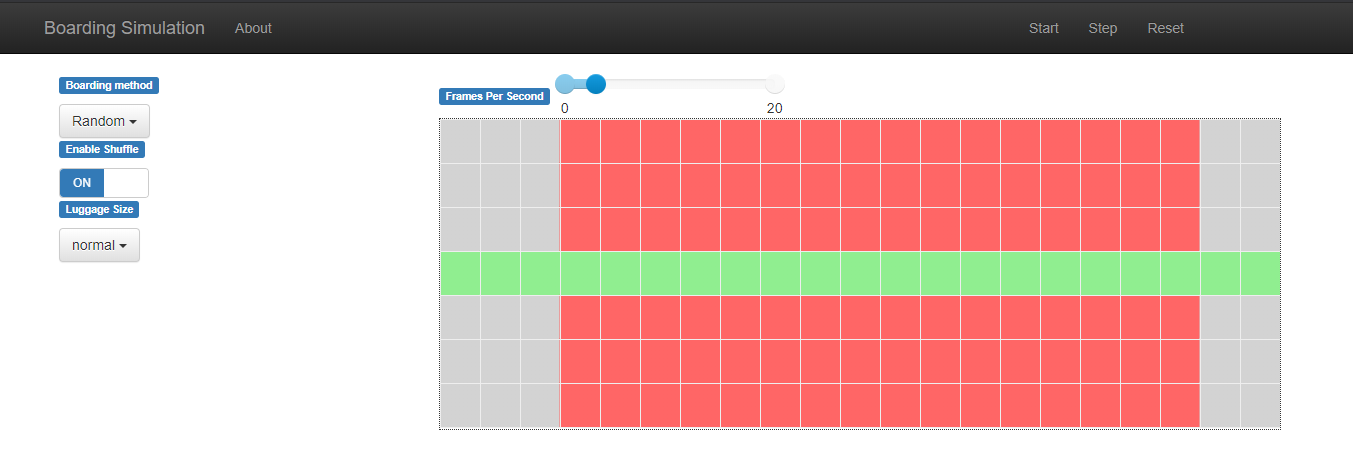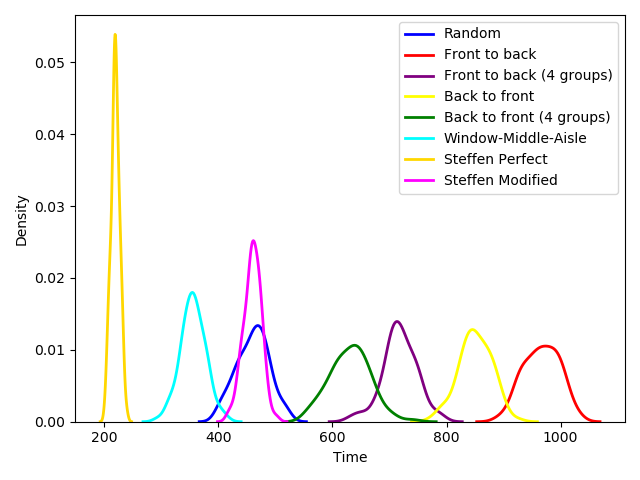The aim of this project it to examine and compare various methods of boarding a plane (16 rows consisting of 6 seats each). Our implementation is based on Mesa - an agent-based modeling framework for Python 3 (more information can be found on https://mesa.readthedocs.io/).
The visualization can be launched by running file "viz.py" (more details here).
To work properly, it requires following libraries installed:
- mesa
- numpy
- pandas
- seaborn
- mathplotlib
File "plane.py" consists of our implementation of 2 types of agents (inheriting from Agent delivered in Mesa) used in our simulation:
- PassengerAgent - as the name may suggest, agents of this class represent a single passenger of a plane. Their most important properties are seat_pos (position of assigned seat), group (number of a boarding group) and baggage (amount of time necessary to stow luggage). Additionally, every agent has a state property, which is used to store information regarding current actions taken by the passenger.
- PatchAgent - this class is used to describe individual cells of the plane. Each patch has assigned type (seat, corridor or wall), which can be used to distinguish them during visualization. However, their most important functionality is provided by containing information used to properly conduct seat shuffles by passengers.
Every agent has assigned unique_id, which allows to distinguish agents from each other - a property required by Mesa, although it allows for better understanding of consecutive steps of the visualization.
Additionally, this file contains PlaneModel - our representation of the plane, a core of every simulation - to which all agents must be assigned. It consists of numerous variables describing conditions of current run (boarding method or amount of baggage) and elements essential for proper functioning of simulation, such as specific grid (MultiGrid allowing for multiple agents on a single cell) and scheduler (QueueScheduler which is explained below).
File "queue_method.py" contains a definition of QueueScheduler - an extension of BaseScheduler delivered by Mesa. Instead of a single agent buffer, the modified version consists of two separate queue - standard and priority. Agents placed in priority queue are guaranteed to progress before those in standard one. Such implementation allows for better control over the flow of simulation, while still being compatible with most of functions in Mesa.
File "methods.py" consists of 8 functions representing boarding methods which we are meant to simulate:
- Random order
- Back to front
- Front to back
- Back to front (4 groups)
- Front to back (4 groups)
- Window-middle-aisle
- Steffen Perfect
- Steffen "Modified"
File "viz.py" consists of elements required for correct visualization of our model. To launch it, ensure that all that all files mentioned in this document are located in the same dictionary and execute:
python3 -m viz.py
After this in your browser should show up new tab (resembling an image below):

The left panel consists of three variables:
- Boarding method (allows for choice of the boarding method)
- Enable shuffle (enables and disables suit shuffles)
- Luggage size (an integer from a range from 0 to 7 or a value drawn from normal distribution)
On the right side, there are three buttons controlling the flow of simulation:
- Start/Stop (turns on and pauses the visualization)
- Step (progresses the simulation by one step)
- Reset (clears the board)
File runes.py contains batch runs whose are collecting data as time (to fully board all passengers), and script where we can exam the impact of seat shuffling on the length of the boarding process. Our results are presented on histograms, where X axis is time line and Y axis is density (https://en.wikipedia.org/wiki/Kernel_density_estimation)
For each method we provided 100 different runs. Below there is a graph comparing performance of 8 presented boarding methods:
The following graphs are meant to visualize the impact of baggage stowing on boarding time in comparison with effect caused solely by seat shuffles. In both groups, the first chart presents the result when seat shuffles are enables and baggage is completely neglected. The following graphs, we compare mean time for disabled seat shuffles and constant time of stowing baggage (respectively: 1, 2, 3, 4 ticks).
- RANDOM
- BACK TO FRONT (4 groups)
It can be noticed that baggage and seat shuffles have similar impact when time of stowing luggage is equal to 3 ticks in both experiments - with further increase of this value influence of baggage increases significantly.


